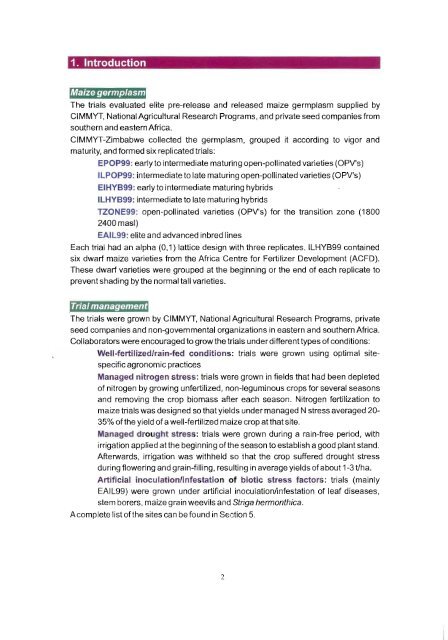n - Search CIMMYT repository
n - Search CIMMYT repository
n - Search CIMMYT repository
You also want an ePaper? Increase the reach of your titles
YUMPU automatically turns print PDFs into web optimized ePapers that Google loves.
1. Introduction<br />
~<br />
The trials evaluated elite pre-release and released maize germplasm supplied by<br />
<strong>CIMMYT</strong>, National Agricultural Research Programs, and private seed companies from<br />
southern and eastern Africa.<br />
<strong>CIMMYT</strong>-Zimbabwe collected the germplasm, grouped it according to vigor and<br />
maturity, and formed six replicated trials:<br />
EPOP99: early to intermediate maturing open-pollinated varieties (OPV's)<br />
ILPOP99: intermediate to late maturing open-pollinated varieties (OPV's)<br />
EIHYB99: early to intermediate maturing hybrids<br />
ILHYB99: intermediate to late maturing hybrids<br />
TZONE99: open-pollinated varieties (OPV's) for the transition zone (1800<br />
2400 masl)<br />
EAIL99: elite and advanced inbred lines<br />
Each trial had an alpha (0,1) lattice design with three replicates. ILHYB99 contained<br />
six dwarf maize varieties from the Africa Centre for Fertilizer Development (ACFD).<br />
These dwarf varieties were grouped at the beginning or the end of each replicate to<br />
prevent shading by the normal tall varieties.<br />
.~<br />
The trials were grown by <strong>CIMMYT</strong>, National AgriCUltural Research Programs, private<br />
seed companies and non-governmental organizations in eastern and southern Africa.<br />
Collaborators were encouraged to grow the trials under different types ofconditions:<br />
Well-fertilized/rain-fed conditions: trials were grown using optimal sitespecific<br />
agronomic practices<br />
Managed nitrogen stress: trials were grown in fields that had been depleted<br />
of nitrogen by growing unfertilized, non-leguminous crops for several seasons<br />
and removing the crop biomass after each season. Nitrogen fertilization to<br />
maize trials was designed so that yields under managed N stress averaged 20<br />
35% ofthe yield ofa well-fertilized maize crop at that site.<br />
Managed drought stress: trials were grown during a rain-free period, with<br />
irrigation applied at the beginning ofthe season to establish a good plant stand.<br />
Afterwards, irrigation was withheld so that the crop suffered drought stress<br />
during flowering and grain-filling, resulting in average yields of about 1-3 tlha.<br />
Artificial inoculation/infestation of biotic stress factors: trials (mainly<br />
EAIL99) were grown under artificial inoculation/infestation of leaf diseases,<br />
stem borers, maize grain weevils and Striga hermonthica.<br />
Acomplete list ofthe sites can be found in Section 5.<br />
2

















